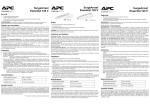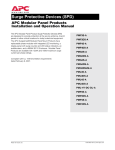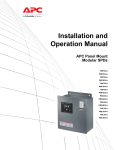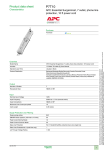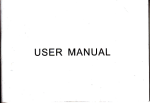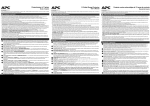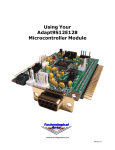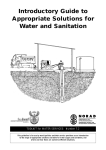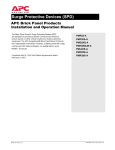Download American Power Conversion PM4Y User's Manual
Transcript
www.apc.com SurgeArrest PM Series ® PM3, PM4, and PM4Y Series Modular Surge Protective Device (SPD) User’s Manual American Power Conversion Corporation 132 Fairgrounds Road P.O. Box 278 West Kingston, Rhode Island 02892 USA APC0212040A SurgeArrest PM Series ® Contents INTRODUCTION ......................................................................................................................................... 1 Installation .............................................................................................................................................. 1 Testing .................................................................................................................................................... 1 UNPACKING AND PRELIMINARY INSPECTION Unpacking and Preliminary Inspection ................................................................................................. 2 Storage .................................................................................................................................................... 2 LOCATION CONSIDERATIONS Environment ........................................................................................................................................... 2 Audible Noise ......................................................................................................................................... 2 Mounting and Cabinet Data .................................................................................................................. 2 Service Clearance ................................................................................................................................... 3 Equipment Performance ........................................................................................................................ 3 Product Orientation ................................................................................................................................ 3 ELECTRICAL CONNECTIONS Overcurrent Protection ........................................................................................................................... 3 Voltage Rating ........................................................................................................................................ 3 Terminals ................................................................................................................................................ 4 System Grounding .................................................................................................................................. 4 Parallel Connection ................................................................................................................................ 4 Wire Size & Installation Torque ............................................................................................................ 5 Disconnect Switch and Circuit Breaker ................................................................................................ 5 PM SERIES INSTALLATION INSTRUCTIONS Installation Instructions ......................................................................................................................... 6 Configuration and Wiring Diagrams .................................................................................................... 7 OPERATION Operation and Features .......................................................................................................................... 9 Status Panel Controls, Indicators and Alarms ...................................................................................... 9 Surge Counter Option ............................................................................................................................ 10 Dry Contacts Option .............................................................................................................................. 10 MAINTENANCE Periodic Inspection and Cleaning .......................................................................................................... 11 Corrective Maintenance and Repairs .................................................................................................... 11 Troubleshooting ...................................................................................................................................... 11 GENERAL INFORMATION Limited Warranty ................................................................................................................................... 17 Technical Support .................................................................................................................................. 17 TABLES Table 1 - Cabinet Dimensions and Weight ............................................................................................ 2 Table 2 - Voltage Rating and Service Type (by Model) ........................................................................ 4 Table 3 - DB-9 Pin Configuration ......................................................................................................... 10 Table 4 - Replacement Parts List ........................................................................................................... 16 i SurgeArrest PM Series ® Contents FIGURES Figure 1 - Typical Parallel Connections ................................................................................................ 4 Figure 2 - Basic PM3 and PM4 Configuration with Disconnect Switch Option ................................ 5 Figure 3 - Basic PM3 and PM4 Configuration and Wiring Diagram .................................................. 7 Figure 4 - Basic PM4Y Configuration and Wiring Diagram ............................................................... 8 Figure 5 - Status Panel with Surge Counter Option ............................................................................. 9 Figure 6 - Troubleshooting Flowchart ................................................................................................... 12 Figure 7 - Display Board Locator Diagram .......................................................................................... 13 Figure 8 - Diagnostic Board Locator Diagram ..................................................................................... 14 Figure 9 - Surge Module Removal and Replacement ........................................................................... 15 ii INTRODUCTION Thank you for choosing the APC SurgeArrest PM3, PM4, or PM4Y Series Surge Protective Device. The APC modular Surge Protective Device (SPD) is a high quality, high energy surge attenuation system that has been designed to protect sensitive equipment from damaging transient voltage surges. Proper installation is imperative to maximize the surge suppressor’s effectiveness and performance. Read and understand all information contained in this manual prior to installation. This manual is to be used as a guide for installing the device. The procedures contained in this manual are not intended to supercede local or national electrical codes. Check all applicable electrical codes to assure compliance. In all instances, local and/or national electric code requirements are to be followed. This device must be installed by a licensed electrician. The electrician should follow the steps outlined in this manual to insure a proper installation. A copy of the installer’s invoice detailing the installation of this device is required in order to obtain warranty service for the device. The APC PM Series modular product line is a parallel SPD designed for service entrance and downstream panelboard applications. The PM Series has one or two modules per phase and is available with a 120kA or 160kA per phase rating. All APC products are extensively tested according to industry standards as set both by IEEE C62.41 and C62.45, for Categories A, B, and C, and are listed by UL 1449 Second Edition, and UL 1283. The connection method of these devices may require several feet of wire. Increased lead length adversely affects clamping voltages. Save this manual! It includes instructions regarding the product warranty and replacement parts. ! DANGER HAZARD OF ELECTRIC SHOCK, BURN, OR EXPLOSION. • Turn off all power supplying this equipment before working on or inside equipment. • Please read the following installation and testing warnings. INSTALLATION Bonding and Grounding Hazard: During installation into an electrical system, SPD’s must NOT be energized until the electrical system is completely installed, inspected and tested. All conductors must be connected and functional, including the neutral (if required). The voltage rating of the device and system must always be verified before energizing the SPD. Failure to follow these guidelines can lead to abnormally high voltage being applied to the SPD. This may cause the SPD to prematurely fail or significantly shorten the effective life. The warranty does not cover an incorrectly installed device. TESTING High Voltage Testing - DO NOT HI-POT TEST Any factory or on-site testing that exceeds the normal operating voltage such as high-potential insulation testing, or any other tests where the suppression components will be subjected to voltages higher than their rated “turn on” voltage must be run with the suppressor disconnected from the power source. For 4-wire TVSS devices, the neutral connection at the TVSS must also be disconnected prior to performing high-potential testing and then reconnected upon completion of the test. Failure to disconnect this surge suppression device and its associated suppression components during elevated voltage testing will result in damage to the suppression components and/or other electronic components. Page 1 Unpacking and Preliminary Inspection • Inspect the entire shipping container for damage or signs of mishandling before unpacking the unit. • Remove the cardboard packing and further inspect the unit for any obvious shipping damages. • If damage found is a result of shipping or handling, immediately file a claim with the shipping company and forward a copy to APC. Storage The unit should be stored in a clean, dry environment. Storage temperature is -40o C (-40o F) to +60o C (+140o F). Avoid exposing the unit to areas of high condensation. All of the packaging materials should be left intact until the unit is ready for installation. If the unit has been stored for an extended period of time, it may be necessary to clean the unit and make a complete inspection of the unit prior to installing and placing into service. LOCATION CONSIDERATIONS The following paragraphs provide information and guidance about what should be taken into consideration before installing an APC SPD. Environment The unit is designed to operate indoors in an ambient temperature* range of -40o C (-40o F) to +60o C (+140o F) with a relative humidity of 0% to 95% non-condensing. The standard unit is in a NEMA Type 1 industrial use enclosure which is intended for indoor use. Primarily, it provides a degree of protection against contact with the enclosed equipment. It should not be installed in areas with excessive dust, flammable materials, corrosive vapors or explosive atmospheres. *Surge Counter option/feature has an operating temperature range of -0o C (32o F) to +60o C (+140o F) Audible Noise The unit background noise is negligible, and does not restrict the location of the installation. Mounting and Cabinet Data The PM Series is designed to be wall mounted. Unit model sizes and weights are defined in Table 1. Model Number Table 1: PM3, PM4, and PM4Y Dimensions and Weights Page 2 12"W x 12"H x 6.25"D (30.48 x 30.48 x 16.13 cm) Weight / Shipping Weight 14"W x 16"H x 6.25"D (35.56 x 40.64 x 16.13 cm) Weight / Shipping Weight PMP3 23 / 25 lbs. (10.43 / 11.43 kg) PMP3D 29 / 32 lbs. (13.15 / 14.51 kg) PMP4 23 / 25 lbs. (10.43 / 11.43 kg) PMP4D 29 / 32 lbs. (13.15 / 14.51 kg) PMF3 23 / 25 lbs. (10.43 / 11.43 kg) PMF3D 29 / 32 lbs. (13.15 / 14.51 kg) PMF4 23 / 25 lbs. (10.43 / 11.43 kg) PMF4D 29 / 32 lbs. (13.15 / 14.51 kg) PML3 23 / 25 lbs. (10.43 / 11.43 kg) PMG3D 29 / 32 lbs. (13.15 / 14.51 kg) PML4 23 / 25 lbs. (10.43 / 11.43 kg) PMG4D 29 / 32 lbs. (13.15 / 14.51 kg) PMG3 23 / 25 lbs. (10.43 / 11.43 kg) PML3D 29 / 32 lbs. (13.15 / 14.51 kg) PMG4 23 / 25 lbs. (10.43 / 11.43 kg) PML4D 29 / 32 lbs. (13.15 / 14.51 kg) PML3S 24 / 26 lbs. (10.88 / 11.79 kg) PML4DS 30 / 33 lbs. (13.60 / 14.96 kg) PMG4S 24 / 26 lbs. (10.88 / 11.79 kg) PMG4DS 30 / 33 lbs. (13.60 / 14.96 kg) PML4S 24 / 26 lbs. (10.88 / 11.79 kg) 24"W x 24"H x 7"D (61.0 x 61.0 x 17.8 cm) Weight / Shipping Weight PMF3S 24 / 26 lbs. (10.88 / 11.79 kg) PML4Y/DC/DL 65 / 78 lbs. (29.45 / 35.34 kg) Service Clearance In addition to national and local code requirements, 36 inches of service clearance is needed at the front of the SPD. Equipment Performance To obtain the maximum system performance, the unit must be located as close to the circuit to be protected as possible, minimizing the interconnecting wire length. For every foot of wire length, approximately one (1) nanosecond of turn-on/ turn-off time will be added, and approximately 175 volts (6kV/3kA, 8/20 microsecond) will be added to the clamp voltage. For optimum transient surge protection, staged surge suppression should be implemented at the service entrance and all other electrical connections to the building (telephone, CATV, etc.). It should also be implemented at recognized surge generating loads within the building (arc welding rigs, large motors, switched capacitors, etc.). Additionally, it should be implemented for sensitive electronic loads (computer equipment, facsimile machines, copy machines, solid state motor drives, variable frequency drives, etc.). For interconnected electronic loads (via data cabling), surge protective devices should also be utilized to protect the devices on either end of interconnecting data cables. APC Manufactures a complete line of surge protection devices for both alternating current (AC) and direct current (DC) applications. Contact an authorized APC reseller, or order directly from, APC at www.apc.com. Product Orientation To decode the Model Number and determine the unit’s configuration, locate the printed nameplate on the top of the unit. Note: The Serial Number, Date of Manufacture, and UL 1449 Suppression Voltage Rating (SVR) are also on the unit identification nameplate. The Model Number can be decoded as follows: • PM identifies a SurgeArrest Panel Mount product. The following letter indicates the voltage and wiring configuration of the device. • Following the alpha character is the number 3, 4, or 4Y. 3 and 4 indicate SurgeArrest Panel Mount units with one replaceable module per phase, rated at 120kA or 160kA respectively. 4Y indicates a SurgeArrest Panel Mount unit with 2 replaceable modules per phase, rated at 160kA per phase. • Following the letter designation is optional equipment, shown as: /AA = Audible Alarm, /DC = Dry Contact, /IL = Indicator Lights, /DS = Disconnect Switch, DL = Thru-door Disconnect Switch. Options are detailed later in this manual. ! WARNING VERIFY THAT ALL POWER CIRCUITS ARE DE-ENERGIZED BEFORE MAKING CONNECTIONS All electrical connections should be performed by a qualified (licensed) electrician. All wiring must comply with the National Electric Code (NEC) and applicable local codes. ELECTRICAL CONNECTIONS Overcurrent Protection The Surge Protective Device (SPD) draws very little current under normal conditions and will only conduct for a brief duration upon encountering a transient surge voltage. APC SPD’s contain UL Listed internal fusing to protect against abnormal voltage conditions. Note: Fuses are not replaceable. Voltage Rating Prior to mounting the SPD, verify that the unit has the correct voltage rating by checking the nameplate voltage or model number. The service type should match the intended power source. See Table 2 for the voltage rating and service type of the SPD. Page 3 Table 2: Voltage Rating and Service Type (by Model) M ode l Numbe r Voltage Rating and Se rvice Type PMP3, PMP3D, PMP4, and PMP4D 120/240 Volts, Single Phase PMF3, PMF3D, PMF3S, PMF4, and PMF4D 120/208 Volts, 3- Phase, WYE, 5 Wire PMG3, PMG3D, PMG4, PMG4D, PMG4S, and PMG4DS 277/480 Volts, 3- Phase, WYE, 5 Wire PML3, PML3D, PML3S, PML4, PML4D, PML4S, PML4Y, and PML4DS 347/600 Volts, 3- Phase, WYE, 5 Wire Terminals Terminals have been provided inside the APC modular SPD units for the line (phase), neutral, and equipment safety ground connections. Terminal wire size for all models is #8 AWG - #1 AWG. Installation torque is 65 inch-pounds. System Grounding An equipment grounding conductor must be used on all electrical circuits connected to the SPD. This requirement is primarily for safety, although SPD performance is enhanced by proper grounding. Proper operation of any surge suppression system or device depends on a proper grounding system. Incorrect grounding practices will reduce the effectiveness or interfere with SPD system operation and performance, as well as endanger personnel and equipment. For the best performance, use a single point ground system where the service entrance grounding electrode system is connected to and bonded to all other available electrodes, building steel, metal water pipes, driven rods, etc. For sensitive electronics and computer systems, it is recommended that the ground impedance measurement be 25 ohms or less. When metallic raceway is used as an additional grounding conductor, an insulated grounding conductor should be run inside the raceway. Adequate electrical continuity must be maintained at all raceway connections. Do not use isolating bushings to interrupt a metallic raceway run. A separate isolated ground for the SPD is NOT recommended. Proper equipment connections to grounding system and ground grid continuity should be verified via inspections and testing on a regular basis as part of a comprehensive electrical maintenance program. On 4-Wire Power Systems, neutral to ground bonding should be installed per the NEC. Failure to do so could cause equipment damage. Parallel Connection When making a parallel type of connection (Figure 2), the length of the wiring to the Surge Protective Device (SPD) must be kept as short as possible to substantially enhance the performance. Long wire runs are to be avoided for the unit to perform as intended. To reduce the impedance the wire displays to surge currents, the phase, neutral (if used), and ground conductors are to be routed within the same conduit and should be tightly bundled or twisted together to optimize the performance of the unit. Sharp bends in the conductors are to be avoided. NOTE: Safety Ground required for ALL units. Page 4 Figure 1. Typical Parallel Connections Wiring Size & Installation Torque With a parallel connection, the size of the wiring to the SPD is independent of the ampere rating of the circuit to be protected. The recommended wire size is based on the unit’s transient surge current capabilities. #6 AWG is the recommended wire size for phase, neutral and ground conductors. Disconnect Switch The PM Series is designed for connection to a 30A to 60A breaker. The PM3 and PM4 Series SPDs can be equipped with an optional internal disconnect switch (Figure 2). The disconnect switch provides a means to de-energize the entire suppressor, to facilitate servicing of unit’s components. (See Warning regarding the Neutral when testing the distribution system). The PML4Y/DC/DL is equipped with an internal disconnect switch with an external manual operator located on the exterior of the enclosure. Before opening the enclosure door the external manual operator must moved to the “OFF” position. This will de-energize the entire suppressor to facilitate servicing of the unit’s components. To re-energize the suppressor, close the door and move the external manual operator to the “ON” position. NOTE: A disconnect switch will add length, which increases the response time and the clamp voltage. To minimize the additional led length and optimize performance, units are available with an optional internal disconnect switch. The disconnect switch is not a device that can be added to the unit after purchase. It must be ordered with the unit as the mounting cabinet is larger for units having the option. If an internal disconnect switch is to be used, the location of the SPD and the disconnect switch should be planned out carefully to avoid excessive lead length when wiring the devices. Figure 2: Basic PM Configuration with Disconnect Switch Option (Daughterboard for Optional Surge Counter Shown) ! WARNING VERIFY THAT ALL POWER CIRCUITS ARE DE-ENERGIZED BEFORE MAKING CONNECTIONS All electrical connections should be performed by a qualified (licensed) electrician. All wiring must comply with the National Electrical Code (NEC) and applicable local codes. **Surge Protective Devices are designed for use on the load side of the service entrance disconnect only** Page 5 PM SERIES INSTALLATION INSTRUCTIONS (Typical Unit - Three Phase WYE, 4 Wire, plus Ground) This section provides basic installation instructions for the PM Series SPD. Per UL 1449 Paragraph 1.4, SPD’s “are intended for installation on the load side of the main overcurrent protection”. Locate the SPD as close as possible to the circuit to be protected to minimize the wire length. This will optimize SPD performance. Note that these instruction are not intended to supercede local or national codes. The installation should be performed by a licensed electrician. To install a PM Series SPD, refer to the diagrams on the following pages and proceed as follows: 1. Unpack and inspect the unit for signs of damage. If the unit is damaged, contact APC Customer Service (1-800-8004APC). See Page 17 for obtaining service under the Warranty. 2. Warning: Disconnect power while installing the SPD. Attempting to install while energized may result in death or injury. The installation should be performed by qualified electrical personnel. 3. Locate where the unit is to be installed. Ensure wire lengths between the SPD and the service panel are kept to a minimum. 4. Use an AC voltmeter to check all voltages to ensure that the proper unit has been selected. After verifying the proper unit has been selected, remove power from the AC distribution panel. 5. Open the door on the unit by loosening the two screws that secure the door latches in place. Slide the top latch upward and rotate it so that it no longer secures the door. Slide the bottom latch downward and rotate it so that it no longer secures the door. Drill a hole large enough to allow for the installation of the correct sized UL approved conduit with anti-short bushings (not supplied) to accommodate the wiring being installed. NOTE: In order to keep wiring length and bend radii at a minimum, APC recommends that wiring be installed through the left side or bottom of the SPD. APC also recommends that the hole be sealed with putty after wiring installation.. 6. 7. Drill four (4) pilot holes (mounting holes in the SPD are 5/16” in diameter) to provide for mounting of the SPD. Mount the devices via the flanges as close as possible to the panel being protected. 8. Connect the unit to the service panel through the UL approved conduit with anti-short busings. The connecting wires should be twisted together or tightly bundled and kept as short as possible to enhance the performance of the SPD. Terminal wire size is #8 AWG to #1 AWG. Torque screws to 65 inch-pounds. The recommended wire size for phase, neutral, and ground is #6 AWG. Connect a wire (in conduit) to the safety ground bus of the distribution panel, and to the ground connections of the SPD as show in the diagram on the following page, and as marked on the unit. Proper grounding is essential, use a green wire or yellow/green striped wire for the ground connection. Connect a wire (in conduit) to the NEUTRAL bus of the panel and to the NEUTRAL connector of the SPD as marked on the unit. Use a white wire or make with a white band for the neutral connection. Connect a wire (in conduit) to each phase (HOT) feed on the LOAD side of the three-pole breaker. Be sure the breaker is turned OFF prior to making any connections of any kind. If a breaker is not available, then it will be necessary to install or connect to an existing main disconnnect switch (on the LOAD side). Disconnect switches are available from APC as an option and must be specified at the time of purchase; the disconnect is not an “add-on” devide and may change the size of the enclosure. Be sure the disconnect switch is open (OFF) and the power is secured before making any connnections. Refer to the diagram on the following page and the marking on the unit when connecting the phase wires. After all connections have been made and not hazards exist, restore power to the panel, breaker, or disconnect switch as required. If the SPD is installed and functioning properly, the green LED indicators on the front panel display will be lit, the mdoule LED indicators will be lit, and there will be no audible or visual alarms.. For answers to questions about installation, call APC’s Customer Service Department at: 800-800-4APC. Page 6 Figure 3: Basic PM3 and PM4 Configuration and Wiring Diagram (3-Phase WYE, 4-Wire, plus Ground) Page 7 Neutral Conductor 5/16” Mounting Hole (4 places) Mounting Flange (4 places) Surge Module with LED (9 places) Phase C Connector Phase A Phase B Connectors Ground Conductor Fuse (9 places) Disconnect Not to exact scale. Door removed for clarity Figure 4. Basic PM4Y Configuration and Wiring Diagram (3-Phase WYE, 4-Wire, plus Ground) Page 8 Operation and Features SPD’s do not require a great deal of operator intervention after installation. NOTE: The PM Series has a green LED for each phase which extinguishes when the module is no longer providing protection (fault condition). All of the PM Series of SPDs contain a diagnostic circuit which monitors the suppressor status continuously and automatically. If a fault condition were to occur, the built-in front panel audible alarm will sound and a red “Service” LED will light, indicating that the unit is in need of service by a qualified technician. The audible alarm can be silenced by pressing the “Mute Alarm” button on the touchpad, until a qualified electrician or service person is available to service the unit. The red “Service” LED will continue to be illuminated even though the audible alarm has been silenced. This will continue until the fault condition has been cleared. Each of the internal surge protection modules have a green LED that lights to signify that the module is on-line and functioning properly (the N-G module does not have an LED). In addition to module LED’s, the front panel also displays the status of each internal module by use of diagnostically controlled green LED’s. This technique ensures that a false indication does not occur if an LED were to burn out. A true/hard fault condition can be confirmed by having an audible alarm with the red “Service” LED lit, as well as any module LED and front panel status LED extinguished. By utilizing all of these built in diagnostic features, an operator can more easily determine if a hard fault exists or if a status LED is faulty. If power is applied the SPD and one or more of the module LED’s are extinguished and any diagnostic LED on the font panel concurs with any module LED, then the faulted module may need to be replace. Use the troubleshooting section of the manual to locate and repair the fault. Status Panel Controls, Indicators and Alarms All indicators and controls are located on the front diagnostic panel (Figure 5) of the SPD unit. Each phase features a tricolor LED indicator. Green indicates correct operation. Amber indicates reduced protection. Red indicates loss of protection. If an inoperative condition where to occur, the built-in audible alarm will sound and the red Service LED will illuminate. This indicates that the unit needs evaluation by a qualified electrician or technician. Until a qualified person evaluates the unit, press the Mute Alarm touchpad to silence the alarm. (The LED indicator above the Mute Alarm touchpad illuminates when the alarm is deactivated. Normal operation occurs with the Mute Alarm LED extinguished.) The red Service LED will remain illuminated even though the Audible Alarm has been silenced. The Test touchpad tests the red Service LED and the Audible Alarm. If LEDs are illuminated in a manner that suggests contradictory information, there may be an internal logic problem and the unit needs replacement. If none of the LEDs are illuminated, the unit may not be installed correctly. Please note that the internal storage capacitor for surge counter backup must be energized for about 15 minutes before the “count” push button will function. If a green LED is not illuminated and is suspect of being faulty, a qualified electrician or technician may attempt to diagnose the problem by de-energizing the unit, removing the front cover and exchanging ribbon cable leads with another phase (if available). Upon reenergizing the SPD, the appropriate LED will illuminate if the suspect LED has failed. If troubleshooting indicates a failed LED, please contact APC Technical Support at: 800-800-4APC. Figure 5. Status Panel with Surge Counter Option Page 9 Surge Counter Option In units so equipped, the surge counter option provides a means to total the number of transient voltage surges encountered since the counter was last reset. The surge counter circuitry includes a “supercap”. This will provide power up to four days to retain memory should a power outage occur. NOTE: There is a 10 - 15 minute charging cycle once power is connected, before the surge counter operates. The surge counter registers the sum of L-N and L-G transient surges. There are Count and Reset touchpads. Pressing the Count touchpad increments the counter by one. Pressing the Reset touchpad resets the counter to zero count. Dry Contacts Option The PM Series is available with optional Dry Contacts which utilize a DB-9 connector. This feature provides two sets of both normally open (N.O.) and normally closed (N.C.) contacts through the DB-9 connector. These relay contacts can be used for remote indication of the SPD’s operating status by changing state when there is an alarm condiiton.. Examples could include a computer interface board, an emergency management system, etc. The relay contact pin arrangement is outlined in Table 3. (Please note the jumpered connections. Pins 7, 8 & 9 do not represent a third set of contacts.) For custom applications using the Dry Contacts, please note the following information: • The Dry Contacts are designed for low voltage or control signals only. • Maximum switching current is 1 amp. • Maximum switching voltage is 24 volts, DC or AC. Higher energy application may require additional relay implementation outside the PM. Damage to the PM’s relay caused by implementation with energy levels in excess of those discussed in this manual will not be covered by warranty. If you have design questions, please contact APC at: 1-800-800-4APC. Table 3: DB-9 Relay Contact Pin Configuration PIN C O N T A C T T YP E 1 No rm al l y Cl o s e d (1) 2 Co m m o n (1) 3 No rm al l y Op e n (1) 4, 7 No rm al l y Cl o s e d (2) 5, 8 Co m m o n (2) 6, 9 No rm al l y Op e n (2) NOTE: Pin pairs 4 & 7, 5 & 8, and 6 & 9, are connected via jumper internally. The combined current of each pin pair may not exceed 1 Ampere. Page 10 WARNING • MAINTENANCE OF THIS SURGE PROTECTIVE DEVICE SHOULD BE PERFORMED BY QUALIFIED ELECTRICAL PERSONNEL ONLY. • DURING NORMAL OPERATION, HAZARDOUS VOLTAGES ARE PRESENT INSIDE THE UNIT. • WHEN SERVICING THIS UNIT, BE SURE TO FOLLOW ALL ELECTRICAL SAFETY PRECAUTIONS. • ALL POWER SOURCES TO THIS UNIT SHOULD BE LOCKED OFF BEFORE SERVICING. THIS WILL PREVENT THE RISK OF RECEIVING AN ELECTRICAL SHOCK. Periodic Inspection and Cleaning Inspection of the SPD should be performed periodically to maintain reliable system performance and continued transient voltage surge protection. While it is difficult to establish a preventive maintenance schedule because conditions vary from location to location, inspections for trouble utilizing the on-line diagnostics should be performed on a routine basis, weekly or monthly. Every effort should be made to ensure that the SPD remains clean and dry. A towel may be used to wipe the exterior of the enclosure. Avoid excess moisture and dry with a towel as appropriate. Corrective Maintenance and Repairs Surge Protective Devices (SPD) are designed for years of reliable, trouble free operation. Unfortunately, even the most reliable equipment can fail. Built-in diagnostics are an integral part of the SPD and will aid in isolating which of the protection module(s) have failed. To keep the SPD operating at peak performance, replacement of any bad module should be performed according to surge module removal and replacement instructions at the earliest service opportunity. If a single module on a particular phase fails, the fuse takes the module off-line. It is recommended by APC that if a module fails on any specific phase, that all modules on that phase be replaced at the same time, according to module removal instructions that follow. Standard troubleshooting procedures should be used to isolate other problems not associated with failed modules. Fee Figure 6 (Troubleshooting Flowchart) for assistance. Replace bad components with identically rated parts to continue proper operation and safety. It is very important that fuses be replaced with the exact fuse specified on the fuse replacement warning label shipped with each unit. This label is found on the SPD mounting plane. After all failed modules have been replaced, prior to returning power, inspect the entire SPD for other damaged components and replace as necessary. Table 4 lists typical replacement parts. Troubleshooting Troubleshooting of an SPD consists of performing the sequence of steps provided in the Troubleshooting Flowchart in Figure 6. Perform the steps in this chart only to the extent necessary to clear the failt. Page 11 Figure 6: Troubleshooting Flowchart Page 12 WARNING • MAINTENANCE OF THIS SURGE PROTECTIVE DEVICE SHOULD BE PERFORMED BY QUALIFIED ELECTRICAL PERSONNEL ONLY. • DURING NORMAL OPERATION, HAZARDOUS VOLTAGES ARE PRESENT INSIDE THE UNIT. • WHEN SERVICING THIS UNIT, BE SURE TO FOLLOW ALL ELECTRICAL SAFETY PRECAUTIONS. • ALL POWER SOURCES TO THIS UNIT SHOULD BE LOCKED OFF BEFORE SERVICING. THIS WILL PREVENT THE RISK OF RECEIVING AN ELECTRICAL SHOCK. Display Board Removal & Replacement Instructions To remove the Display Board, refer to Figure 7 and proceed as follows: 1. Disconnect power to the SPD. 2. Open the door on the unit by loosening the two screws that secure the door latches in place. Slide the top latch upward and rotate it so that it no longer secures the door. Slide the bottom latch downward and rotate it so that it no longer secures the door. 3. Remove the nuts that secure the display board to the panel, then remove the board. 4. Remove the connectors one at a time from the existing board and insert them into the appropriate connector on the replacement board. 5. Install the replacement board into the panel, install the nuts and tighten securely. 6. Close and secure the cabinet door and apply power to the SPD. Figure 7: Display Board Locator Diagram Page 13 Diagnostic Board Removal & Replacement Instructions To remove the Diagnostic Board, refer to Figure 8 and proceed as follows: 1. Disconnect power to the SPD. 2. Remove the board from the standoffs. 3. Remove the connectors one at a time from the existing board and insert them into the appropriate connector on the replacement board. 4. Install the replacement board onto the standoffs. Models PM3 and PM4 Figure 8: Diagnostic Board Locator Diagram Diagnostic Board Page 14 Model PML4Y Surge Module Removal & Replacement Instructions Surge modules within the SPD may become damaged and require replacement. To remove and replace a surge module, refer to Figure 9 and proceed as follows: 1. Disconnect power to the SPD. 2. Open the door on the unit by loosening the two screws that secure the door latches in place. Slide the top latch upward and rotate it so that it no longer secures the door. Slide the bottom latch downward and rotate it so that it no longer secures the door. 3. Remove the two allen-head screws that secure the surge module to the chassis. 4. Pull the surge module out of the chassis. 5. Note the location and part number of each module removed as this information is not supplied elsewhere in the cabinet. NOTE: Surge Modules should only be replaced with a new module having the same part number as the removed module. 6. Unpack and inspect the replacement surge module for damage. If the replacement module is damaged, contact APC Technical Support. 7. Align the replacement surge module with the mounting holes in the chassis. Install the two allen-head screws removed in step 3 and torque to 65 inch-pounds. 8. Power up the SPD and verify that the green LED is lit and that all alarms have cleared. Figure 9: Surge Module Removal and Replacement Page 15 Replacement Parts Listing APC offers the items listed in Table 4 as field replaceable items. Table 4: Replacement Parts List APC M ode l Numbe r Voltage Sys te m De s cription Part Works With: M4 208/120V, 3-Phase WYE 240/120V, Split Phase 160kA Phase Module all PMP4 units M4N 208/120V, 3-Phase WYE 240/120V, Split Phase 160kA N-G Module all PMP4 units MG4 480/277V 160kA Phase Module all PMG4 units MG4N 480/277V 160kA N-G Module all PMG4 units ML4 600/347V 160kA Phase Module all PML4 units ML4N 600/347V 160kA N-G Module all PML4 units ML2 600/347V 80kA Phase Module all PML4Y units ML2N 600/347V 80kA N-G Module all PML4Y units M3 208/120V, 3-Phase WYE 240/120V, Split Phase 120kA Phase Module all PMP3 units M3N 208/120V, 3-Phase WYE 240/120V, Split Phase 120kA N-G Module all PMP3 units MG3 480/277V 120kA Phase Module all PMG3 units MG3N 480/277V 120kA N-G Module all PMG3 units ML3 600/347V 120kA Phase Module all PML3 units ML3N 600/347V 120kA N-G Module all PML3 units RF all Fuse (for all modular units) all modular units DB 208/120V, 3-Phase WYE 240/120V, Split Phase 120 Volt Diagnostic PCB all modular PMP, PMF units D BG 480/277V 277 Volt Diagnostic PCB all modular PMG units D BL 600/347V 347 Volt Diagnostic PCB all modular PML units SB all Surge Counter PCB all modular units with Surge Counter D PB all Display PCB all 120/160kA units without Surge Counter D PBS all Display PCB with Surge Counter all 120/160kA units with Surge Counter DL all Disconnect Switch all PML4Y units Page 16 LIMITED WARRANTY APC warrants it’s AC Panel protection products against defective workmanship and materials for 5 years from the date of original purchase. The panel protection device must be installed by a qualified and licensed electrician in order to qualify for warranty protection. Liability is limited to the replacement of the defective product. A Return Material Authorization must be given by APC prior to the return of any product. (see Technical Support and Customer Service). A copy of the invoice from the installer (electrician or electrical service company) must accompany the defective device being returned. If the return of a device is authorized by APC, APC will immediately ship a replacement unit to the customer. Along with the replacement unit, APC will include a pre-paid shipping tag for the return of the originally defective unit. The replacement unit will not be warranteed unless the defective unit is received by APC. Under no circumstances is APC responsible for the cost of removal or installation of any panel protection device. APC specifically disclaims all other warranties, expressed or implied. Additionally, APC will not be responsible for incidental or consequential damages resulting from any defect in any product or component thereof. Technical Support and Customer Service United States and Canada: 1-800-800-4APC This manual, as well as information about the entire APC product line is available on the internet at: www.apc.com. Prior to calling APC for technical assistance, please have the following information available: Model Number of unit: Serial Number of unit: Manufacture Date: Purchase Date: Your Order Number: Return Shipment Address: American Power Conversion Corporation 1600 Division Road Dock 25 West Warwich, RI 02893 Attn: RMA # Page 17 www.apc.com American Power Conversion Corporation 132 Fairgrounds Road P.O. Box 278 West Kingston, Rhode Island 02892 USA
























